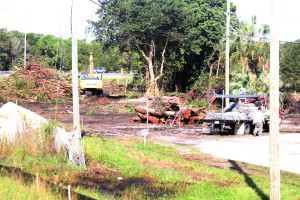Last night after 11:30PM the last item on the Jupiter Town Council meeting was a vote on the alignment of the island way road, which is slated to pass through Limestone Creek, Baker's Park and Kennedy estates. The road which was stalemated in the Palm Beach County Board of Commissioners in mid-October in 3-3 locked decision, was unanimously passed last night by the Jupiter City Council. The decision specifically was to spend $600,000 to buy 7 parcels of property needed to install the road. This purchase will be fast tracked as a quick sale and is expected to be purchased no later than December 31st! There were only 6 people in opposition to the road present, one of which will have it right at his doorstep.
Although the county did not pass it in October, it can be revisited by them since it was a tie and the Jupiter Town Council stated that they intend to urge them to revisit it. Last night Karen Golonka invited all the opposition to contact her as she would not tolerate the misinformation and insults that the Palm Beach County Board of Commissioners tolerated when they took the vote in October, so bring it to her folks!
Please call/send an e-mail to the council members of Jupiter and voice your opposition to this road!
(561) 746-5134
towncouncil@jupiter.fl.us
Contact PBC Commissioner Hal Valeche and encourage him to keep this off the PBCBC agenda!
(561) 355-2201
HValeche@pbcgov.org
Key Talking Points:
-The corporate welfare for biotechnology in the state of Florida must end. $600,000 towards land acquisition for a road that may or may not be approved and does not have the required approval of Palm Beach County Board of Commissioners is a wasted investment.
-It is irresponsible that the council put this item on as the last item at the peak of holiday season after a huge town issue that went on for 3 hours. Agenda items are only released 2 days before a meeting, so it is difficult to organize quickly around issue. In order for this road to be full steam ahead it must have the approval of Palm Beach County Commission and it does not.
-The road is slated to go through Limestone Creek a community that was founded by freed slaves and has been at the hands of colonialist decision making since its inception. This is no different. The residents of Limestone creek voiced their opposition to the road, and PBC Board of Commission was split because of this. The town of Jupiter should not ignore the concerns they had:
-increased risk of safety to pedestrians/children that walk and bike to school/work
-increased pollution, noise pollution, and traffic of 5,000 vehicles per day
-unidentified bio-hazardous waste will be transported on this road.
An accident transporting it is not if, but when.
-picking a historically black community to put this road through is a strategy that bodies of power often do to win their poisonous proposals: put the most toxic substances through the communities that are least empowered to fight. This is why it is considered environmental racism.
-increased pollution, noise pollution, and traffic of 5,000 vehicles per day
-unidentified bio-hazardous waste will be transported on this road.
An accident transporting it is not if, but when.
-picking a historically black community to put this road through is a strategy that bodies of power often do to win their poisonous proposals: put the most toxic substances through the communities that are least empowered to fight. This is why it is considered environmental racism.
-As the project is slated now, it will result in further habitat loss of the Florida state listed threatened Gopher tortoise.
FURTHER READING:PB Post Article about the vote before it happened. Please comment on article!
Jupiter Town Council Agenda for Dec 18th 2012- Item 100-12
Article on the PBC Board of Commission dropping the proposal in October of this year




